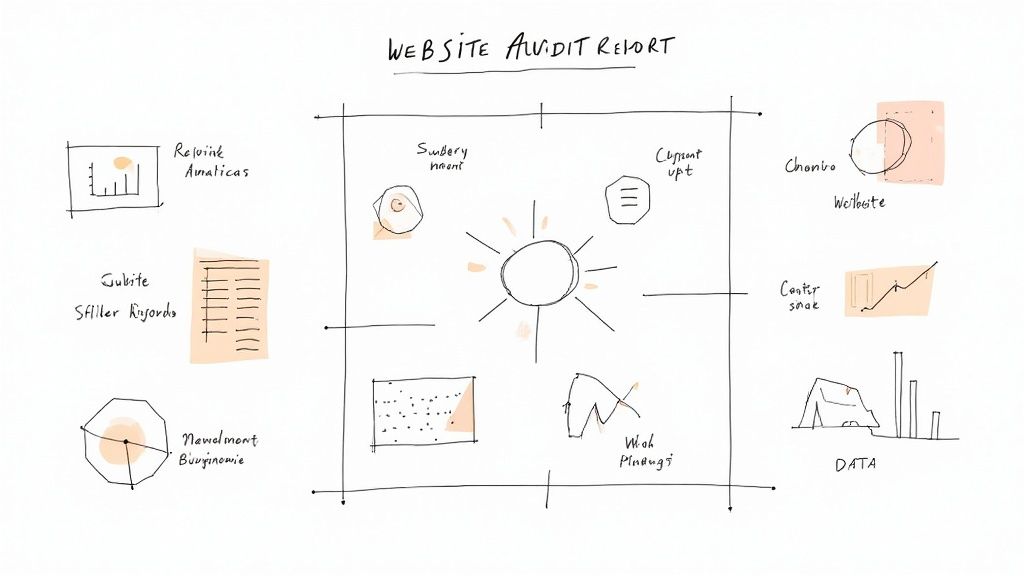Mastering Website Audit Reports: From Basics to Strategic Impact
A website audit report is no longer just a technical checklist. It's a vital strategic tool for businesses looking to improve online performance, create a better user experience, and boost conversions. Consider it an annual health check for your website, catching potential issues before they escalate into major problems. This proactive strategy keeps your website healthy, competitive, and poised for success.

Why Website Audits Are Essential
Modern websites are intricate ecosystems requiring multifaceted analysis that goes beyond simply checking for broken links. A truly effective audit dives deep into technical performance, evaluating factors like page load speed and mobile responsiveness.
It also assesses the user experience, focusing on navigation, site structure, and the clarity of your content. Finally, it scrutinizes conversion optimization, analyzing how effectively the website guides visitors toward desired actions.
A comprehensive website audit reveals hidden opportunities often overlooked. These can range from quick fixes that improve search engine rankings to strategic content adjustments that better resonate with your target audience.
For instance, an audit might uncover slow-loading images that hinder mobile users, leading to higher bounce rates and lost conversions. Addressing this can drastically improve user satisfaction and, ultimately, business outcomes.
Website audit report templates are crucial for digital marketing agencies and SEO professionals because of the complex nature of modern website evaluations. Current templates typically analyze over 50 critical website points covering security, speed, SEO, content quality, and user experience to offer a complete overview of website health.
Free templates available today can assess factors like page load times, broken links, meta tag accuracy, and mobile responsiveness. These directly impact search engine rankings and user retention. Learn more about website audit report templates here.
The Strategic Impact of Audits
Savvy businesses understand the importance of regular website audits. They recognize that the online world is always changing, so what worked in the past may not work today. Consistent website evaluations are essential for staying relevant online and achieving measurable results.
Comprehensive audits give businesses a competitive advantage. They pinpoint weaknesses in their online presence and reveal areas where competitors are struggling. The real strength of an audit lies in its ability to turn data into actionable insights.
This data-driven approach empowers businesses to prioritize improvements, allocate resources efficiently, and ultimately reach their business goals. Regular website audits are an investment, not a cost. They offer a roadmap for continual improvement, ensuring your website remains healthy, performs optimally, and delivers strong results.
This translates into increased traffic, better engagement, and higher conversion rates, all contributing to a healthier bottom line.
Building the Perfect Website Audit Report Template: Essential Elements

What makes a website audit report truly effective? It's the essential elements within the website audit report template. This section details these critical components, offering a framework used by top digital strategists. We'll explore how these experts structure their reports, from technical SEO to conversion optimization.
Core Components of an Effective Template
A strong website audit report template provides a clear, actionable website performance assessment. It acts as a blueprint, ensuring consistency and complete coverage of all vital areas. This structure allows stakeholders to readily understand the website's current status and identify improvement opportunities.
-
Executive Summary: This concise overview highlights the audit's key findings and recommendations. It’s often the first section stakeholders read, so it must be impactful.
-
Technical SEO: This section dives into the technical underpinnings affecting search engine visibility. Factors include crawlability, indexing, site architecture, and structured data.
-
On-Page Optimization: Here, the focus is on individual page elements like content quality, keyword optimization, meta descriptions, and header tags. These elements directly impact search engine ranking.
-
Off-Page SEO: This part examines external factors like backlinks, social media presence, and online reputation. These influence the site's authority and credibility.
-
User Experience (UX): This crucial element evaluates the site's user-friendliness, including navigation, mobile responsiveness, page load speed, and design. A positive user experience drives engagement.
-
Conversion Rate Optimization (CRO): This section focuses on improving conversion rates by analyzing call-to-actions, landing page design, and checkout flows.
Link-Assistant offers SEO auditing tools with customizable website audit report templates. These allow agencies to create professional, white-label reports, tailoring them to client branding and specific site needs. Common templates often include a Site Audit Summary, Detailed Site Audit, and a Domain Strength report. You can learn more about website audit report templates here.
Prioritizing Recommendations and Actionable Insights
Data is important, but actionable recommendations are what drive results. An effective website audit doesn't just list problems; it offers solutions. This means clearly explaining complex technical issues and their business impact to clients.
For instance, instead of simply reporting "slow page load speed," the report should highlight the consequence: “a one-second delay in page load time can result in a 7% reduction in conversions.” Framing the issue this way encourages action. For a more detailed example, you can review a Sample Website Audit Report from Roast My Web.
Recommendations should be prioritized by their potential impact and implementation difficulty. This lets clients tackle quick wins while planning for long-term improvements. A structured report includes a clear implementation roadmap, complete with timelines and expected outcomes.
Presenting Data Effectively
A visually appealing, easy-to-understand report is more effective. Using charts, graphs, and other visuals simplifies complex data and highlights key takeaways. Organizing the audit into smaller sections with clear headings also enhances readability. The ultimate goal is to empower client decision-making with clear data.
To understand essential components of a comprehensive audit report, consider the following table:
Essential Website Audit Report Sections | Audit Section | Elements Analyzed | Business Impact | Priority Level | |---|---|---|---| | Executive Summary | Key Findings, Overall Recommendations | Sets the stage, provides a high-level overview | High | | Technical SEO | Crawlability, Indexing, Site Architecture, Structured Data | Impacts search engine visibility and indexation | High | | On-Page Optimization | Content Quality, Keyword Optimization, Meta Descriptions, Header Tags | Affects individual page rankings | Medium | | Off-Page SEO | Backlink Profile, Social Media Presence, Online Reputation | Builds authority and trust | Medium | | User Experience (UX) | Site Navigation, Mobile Responsiveness, Page Load Speed, Overall Design | Impacts user engagement and conversion rates | High | | Conversion Rate Optimization (CRO) | Call-to-actions, Landing Page Design, Checkout Processes | Directly affects sales and lead generation | High |
This table summarizes the core sections of a website audit report, emphasizing the analyzed elements, their business impact, and suggested priority levels. Addressing these areas comprehensively helps ensure a successful website.
Turning Data Into Insights: Analytics Integration That Drives Action

A truly powerful website audit report template doesn't just present data; it tells a story. This means going beyond surface-level metrics and understanding the why behind the numbers. Integrating analytics into your website audit report template is key to unlocking these deeper insights. It allows you to connect technical issues with real user behavior, leading to more effective and actionable recommendations.
Uncovering User Behavior Patterns
Imagine a website audit reveals a high bounce rate on a particular landing page. While valuable, this information doesn't explain why users are leaving. Integrating analytics data, such as time spent on page, scroll depth, and exit links, can help pinpoint the friction points. For example, a low scroll depth combined with a high bounce rate might indicate users aren't finding what they need above the fold.
Analyzing user behavior flow can also illuminate how users navigate your website. This can reveal unexpected roadblocks or highlight opportunities to simplify the user journey. Perhaps users are taking a convoluted path to reach key pages. This might suggest a need for improved internal linking or clearer navigation.
This data-driven approach transforms a website audit report template into a strategic roadmap. It guides website owners toward targeted improvements that directly address user needs and pain points. This moves beyond simply fixing technical errors to optimizing the entire user experience.
Connecting Technical Issues to Business Impact
Integrating analytics data also allows you to demonstrate the business impact of technical issues. A slow page load time, for instance, might seem minor. However, when paired with data showing a correlation between page load time and conversion rates, the issue gains new urgency.
For example, imagine analytics reveal that a one-second delay in page load time results in a 5% drop in conversions. The business case for improving site speed immediately becomes clear. This tangible link between technical problems and lost revenue motivates stakeholders to prioritize these crucial improvements.
The result is a more persuasive website audit report focused on the bottom line. It empowers clients to make informed decisions about resource allocation for maximum impact. Website audit report templates incorporating web analytics data like those from Google Analytics are increasingly recognized as strategic business tools. These reports provide insights into user behavior, sessions, demographics, bounce rates, conversion rates, and engagement. A well-structured web analytics report often includes at least eight distinct sections, such as user acquisition overview, behavior flow, conversion tracking, and real-time active users analysis. You can explore these reporting options further here.
Visualizing Data and Creating Compelling Narratives
Presenting complex data clearly, concisely, and engagingly is also essential. This is where data visualization comes in. Transforming raw data into charts, graphs, and dashboards lets clients grasp the key takeaways quickly. This visual approach simplifies complex information, making it more accessible to both technical and non-technical audiences.
Finally, an effective website audit report tells a story. Weaving a compelling narrative around the findings and recommendations helps clients understand the big picture and see the value in the proposed improvements. This transforms raw analytics into actionable insights, motivating stakeholders to improve and achieve their business goals. By combining the technical findings of an audit with behavioral insights from analytics, you create website audit report templates that drive real, measurable results.
From Findings to Solutions: Creating Recommendations That Convert

A website audit report template’s true power resides in its actionable recommendations. These recommendations form the bridge between identifying problems and implementing effective solutions. This section explores how to transform technical findings into strategic action plans that clients understand and, crucially, act upon. This makes your website audit report template a valuable tool for driving real change and achieving measurable improvements.
Prioritizing Issues Based on Impact and Effort
Not all website issues are created equal. Some significantly impact performance but are relatively easy to fix. Others require substantial effort for minimal gain. Effective recommendations prioritize issues based on their impact-to-effort ratio. Think of it as a triage system: address the most critical problems first for maximum impact.
For example, fixing broken links can be a quick win with a noticeable impact on user experience. However, a complete website redesign, while potentially beneficial, demands significant resources and time. By initially focusing on high-impact, low-effort improvements, you can demonstrate quick wins and build momentum for more complex projects. This approach ensures clients see immediate value from the audit. You may also want to review resources on conducting a comprehensive SEO audit, such as this guide on How to master a website SEO audit.
Writing Recommendations That Bridge the Gap
Technical jargon can often alienate clients. Recommendations should be written in clear, concise language that everyone understands, regardless of technical background. Translate technical findings into business terms. For instance, instead of suggesting to "optimize your meta descriptions," explain that "improved meta descriptions will attract more qualified clicks from search engines, increasing website traffic and potential customers."
Each recommendation should explain the reasoning behind the suggestion. This helps clients understand the rationale and builds trust in your expertise. By connecting technical fixes to tangible business benefits, you empower clients to make informed decisions. This translates into stronger buy-in and a higher probability of implementation.
Presenting Solutions With Compelling Evidence
Support your recommendations with data and evidence. Show clients why a change is necessary by demonstrating the potential consequences of inaction. This could involve showcasing data on lost conversions due to slow page load times or highlighting competitor performance for relevant keywords.
Include realistic timelines and clear expected outcomes for each recommendation. This provides a roadmap for implementation and sets clear expectations for success. A clear timeline helps clients budget resources effectively, while defined outcomes allow you to measure the impact of the implemented changes.
Structuring Your Recommendations
A well-structured recommendation framework within your website audit report template ensures clarity and facilitates action. The following table provides a practical guide for structuring and prioritizing your recommendations based on audit findings:
To help you structure your recommendations effectively, we've developed a framework that considers several key factors. This framework will allow you to present a clear, actionable plan for website improvement.
Website Audit Recommendation Framework | Issue Category | Impact Level | Implementation Complexity | Recommended Timeline | Expected Outcome | |---|---|---|---|---| | Broken Links | Medium | Low | 1 Week | Improved User Experience, Increased Crawl Efficiency | | Slow Page Load Speed | High | Medium | 2-4 Weeks | Improved Conversion Rates, Lower Bounce Rate | | Missing Meta Descriptions | Medium | Low | 1-2 Weeks | Increased Click-Through Rate from Search Results | | Poor Mobile Responsiveness | High | High | 4-8 Weeks | Enhanced Mobile User Experience, Higher Mobile Conversions |
This table illustrates how to structure recommendations based on impact level, implementation complexity, recommended timelines, and expected outcomes. By providing a comprehensive and actionable plan for improvement, your website audit report template becomes an invaluable tool for achieving tangible results.
Tailoring Your Audit Template: Industry-Specific Approaches That Work
A website audit report template provides a solid starting point. However, its real power comes from customizing it to specific industries. A generic approach won't uncover the detailed insights needed for real improvement. This is where tailoring becomes essential. Effective digital strategists adapt their website audit report templates to match specific business models and objectives. This section explores how to customize your audit for different sectors, maximizing your report's impact.
Understanding Industry-Specific Needs
Different industries have distinct priorities and key performance indicators (KPIs). An e-commerce site, for instance, prioritizes conversion rates and average order value. A B2B service provider focuses on lead generation and customer acquisition cost. A media site emphasizes page views and time on site. A non-profit organization values donations and volunteer engagement.
Recognizing these differences is the first step in tailoring your audit. By understanding what drives success in each industry, you can analyze the most important metrics. This makes your recommendations relevant and actionable.
Customizing Your Website Audit Report Template
Customization goes beyond simply changing the logo. It involves adjusting the entire audit framework to reflect industry nuances.
-
E-commerce: Focus on checkout process optimization, product page analysis, and mobile shopping experience. Analyze shopping cart abandonment rates and identify friction points in the purchase funnel.
-
B2B Services: Prioritize lead capture forms, case studies, and thought leadership content. Assess the effectiveness of lead nurturing campaigns and identify ways to improve lead quality.
-
Media Sites: Emphasize content engagement, page views, and social sharing. Analyze content performance to improve distribution and audience engagement.
-
Nonprofit Organizations: Focus on donation mechanisms, volunteer recruitment, and community engagement. Assess online fundraising campaigns and find ways to strengthen online community building.
Using Benchmarks and Best Practices
Industry benchmarks provide valuable context for your audit findings. They show how a website performs compared to its competitors. A bounce rate of 40% might be average for one industry but very high for another. Using industry benchmarks helps you pinpoint areas of strength and weakness, empowering clients to make informed decisions.
Best practices also vary by industry. What works for an e-commerce site might not be appropriate for a B2B company. Aggressive pop-up promotions might boost e-commerce conversions but deter potential B2B clients. Understanding these nuances allows you to provide targeted, industry-aligned recommendations.
Communicating Effectively With Specialized Audiences
Adapting your language and visuals for your audience is crucial. A technical report full of jargon might impress developers but confuse marketing managers. Use clear, concise language that everyone can understand. Tailor your visuals to highlight key findings without overwhelming clients with data. This ensures your recommendations are clear, actionable, and impactful.
By tailoring your website audit report template to each industry, you showcase your expertise and understanding of the business. This builds trust, enhances the value of your audit, and fosters strong client relationships.
The Audit Toolkit: Powerful Tools for Creating Professional Reports
Choosing the right tools can significantly impact the quality and efficiency of your website audits. This section explores the essential software and platforms used by leading digital consultants to create compelling and accurate website audit report templates. We'll compare various solutions, from free options suitable for smaller agencies to enterprise-grade systems for complex sites. This will help you navigate the various website audit tools and select the best fit for your needs.
Website Audit Tools: A Comparative Overview
Choosing the best website audit tool depends on your specific needs, budget, and technical expertise. Some tools focus on specific aspects of website performance, while others offer a more comprehensive approach. Understanding these differences is crucial for selecting the right tool.
-
Free Tools: Options like Google's PageSpeed Insights and Google Search Console offer valuable insights into website speed and technical SEO issues. These tools are an excellent starting point for identifying basic problems, particularly for those new to website auditing.
-
Freemium/Paid Tools: Platforms like Semrush, Ahrefs, and Screaming Frog provide more advanced features, such as in-depth site crawls, backlink analysis, and competitor research. These tools offer various pricing tiers, catering to different budgets and project scopes. They empower you to create professional website audit report templates, including white-label options for client presentations.
-
Specialized Tools: Some tools focus on specific areas of website performance. For example, GTmetrix specializes in page speed analysis, while tools like WAVE offer accessibility evaluations. These specialized tools allow deep dives into specific areas needing improvement.
The following table offers a brief comparison of these categories:
| Tool Category | Key Features | Benefits | Ideal For |
|---|---|---|---|
| Free Tools | Basic site speed and SEO analysis | Cost-effective, easy to use | Beginners, small websites |
| Freemium/Paid Tools | Comprehensive site audits, backlink analysis, competitor research | Advanced features, customizable reports | Agencies, businesses with larger websites |
| Specialized Tools | In-depth analysis of specific performance areas | Targeted insights | Addressing specific website issues |
This table helps you choose the tools best suited for your audit projects.
Building Efficient Audit Workflows
Successfully auditing websites isn't just about using individual tools effectively; it's about combining them into efficient workflows. Think of it as an assembly line: each tool contributes to the final website audit report template.
For example, you might start with a site crawl using Screaming Frog to identify technical SEO issues. Then, analyze page speed with Google PageSpeed Insights. Next, review analytics data from Google Analytics to understand user behavior. Finally, compile this information into a comprehensive report using a tool like Semrush or a dedicated reporting platform.
This streamlined approach maximizes insights while minimizing repetitive tasks, allowing you to gather data efficiently. This leaves more time to analyze findings and develop actionable recommendations.
Customizing Reports for Client Needs
Different clients have different priorities. A small business owner might be most concerned with local SEO, while a large e-commerce company focuses on conversion rate optimization. Customizing your website audit report template to address these priorities is essential.
This goes beyond simply presenting data. It means crafting recommendations tailored to each client’s specific needs. For example, prioritize SEO recommendations if a client’s primary goal is increased organic traffic. If improving conversion rates is the main focus, center the report on CRO strategies.
Presenting Data Effectively: Telling the Story
Raw data can be overwhelming. Presenting this data clearly and concisely is crucial for client understanding. Use visuals like charts, graphs, and dashboards to simplify complex information and highlight key takeaways.
For instance, instead of just stating a slow page load time, show a chart illustrating its impact on bounce rate and conversions. This makes the data more tangible and motivates clients to take action. By presenting data visually and building a narrative around your findings, your website audit report template becomes a powerful tool for driving positive change.
Beyond The Report: Turning Audit Insights Into Measurable Results
A website audit report template is a powerful starting point, but the true value lies in transforming its insights into tangible improvements. This requires careful planning, clear communication, and consistent monitoring to ensure long-term success. This section explores how experienced digital consultants maintain momentum throughout the optimization process, from capitalizing on quick wins to measuring the overall impact.
Prioritizing Quick Wins and Long-Term Strategies
A website overhaul, like any project, benefits from a phased approach. Start by tackling quick wins: easily implemented changes with a noticeable impact. Examples include:
- Fixing broken links
- Optimizing images
- Improving meta descriptions
These quick wins demonstrate immediate value and build momentum for more complex tasks.
Concurrently, develop a long-term strategy for addressing larger issues. This might involve a website redesign, content migration, or a comprehensive SEO overhaul. Breaking down these larger projects into smaller, manageable tasks makes the process less overwhelming and allows for continuous progress. This balanced approach ensures both short-term gains and sustainable long-term improvement.
Maintaining Stakeholder Engagement
Keeping stakeholders informed throughout the implementation phase is crucial. Regularly communicate progress, highlighting completed tasks and outlining next steps. Use clear, concise language, avoiding technical jargon. Visual aids, such as dashboards and progress reports, can effectively communicate the impact of the changes. This transparent communication builds trust and reinforces the value of the audit.
Documenting Progress and Measuring Impact
Detailed documentation is essential for tracking progress and demonstrating the effectiveness of implemented changes. Maintain a comprehensive record of all modifications, including dates, descriptions, and individuals responsible. This creates a clear audit trail and facilitates review and analysis.
Measuring the impact of these changes is equally important. Track key performance indicators (KPIs) such as website traffic, bounce rate, conversion rates, and keyword rankings. Compare these metrics before and after implementation to quantify the improvements. This data-driven approach proves the audit's value and justifies ongoing optimization efforts. You might be interested in: How to master website performance metrics.
Establishing Ongoing Monitoring Systems
A website is dynamic and requires continuous monitoring and maintenance. Implement systems for tracking website performance and identifying potential problems before they escalate. This could involve automated website crawls, regular performance testing, and ongoing security scans.
Establish performance benchmarks based on industry standards and competitor analysis. Regularly compare your website's performance against these benchmarks to identify areas for improvement. This proactive approach ensures your website remains competitive and continues to perform optimally.
Developing Maintenance Schedules and Adapting to Change
Develop a regular maintenance schedule for recurring tasks like updating software, reviewing content, and performing security checks. This scheduled maintenance prevents small issues from escalating and ensures smooth website operation. This includes regular reviews of your website audit report template to ensure its continued effectiveness.
The online environment constantly evolves. User expectations, search engine algorithms, and best practices are continually changing. Your website must adapt to remain relevant and successful. Stay informed about industry trends and adjust your strategies accordingly. This adaptability ensures your website continues to meet user needs and performs well.
By focusing on these key areas, you transform a website audit report template from a static document into a dynamic roadmap for continuous improvement. This results in tangible, measurable results, including increased traffic, higher engagement, and improved conversions.
Ready to take your website to the next level? Roast My Web offers AI-powered website auditing, saving you valuable time and providing actionable insights for improved performance. Try Roast My Web today!



